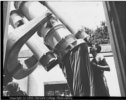Current Status: 57,019 Plates Scanned; 3,365,989,637 Magnitudes.
Primary Scientific Goals
The digitization of the Harvard Astronomical Plate Collection will provide the capability for systematic study of the sky on 100 year time scales.
DASCH will enable new Time Domain Astronomy (TDA) science, including:
- Conduct the first long-term temporal variability survey on days to decades time scales
- Novae and dwarf novae distributions and populations in the Galaxy
- Black hole and neutron star X-ray binaries in outburst: constraining the BH, NS binary populations in the Galaxy
- Black hole masses of bright Quasars from long-term variability measures to constrain their characteristic shortest timescales and thus size
- Quiescent black holes in galactic nuclei revealed by tidal disruption of a passing field star and resultant optical flare
- Unexpected classes of variables or temporal behavior of known objects: preview of what PanSTARSS and LSST may see in much more detail but on shorter timescales)
Enabled by the DASCH scanner
Custom-designed scanner scans two 8 x 10 in plates or one 14 x 17 in plate into 11 micron pixels in only ~80 sec, which will allow ~400 plates/day so that full digitization could be finished in ~3 years when funding is available. Click here for ~2min movie (MS .wmv file) of scanner in action.
To yield lightcurves with ~0.1mag uncertainties over ~100y
Example lightcurve for an eclipsing binary in M44 is available here.Acknowledgements
The DASCH project at Harvard is grateful for partial support from NSF grants AST-0407380, AST-0909073, and AST-1313370; which should be acknowledged in all papers making use of DASCH data.We acknowledge the one-time gift of the Cornel and Cynthia K. Sarosdy Fund for DASCH, and thank Grzegorz Pojmanski of the ASAS project for providing some of the source code on which the DASCH web-interface is based.
The ongoing AAVSO Photometric All-Sky Survey (APASS) has improved DASCH photometric calibration and is funded by the Robert Martin Ayers Sciences Fund.

